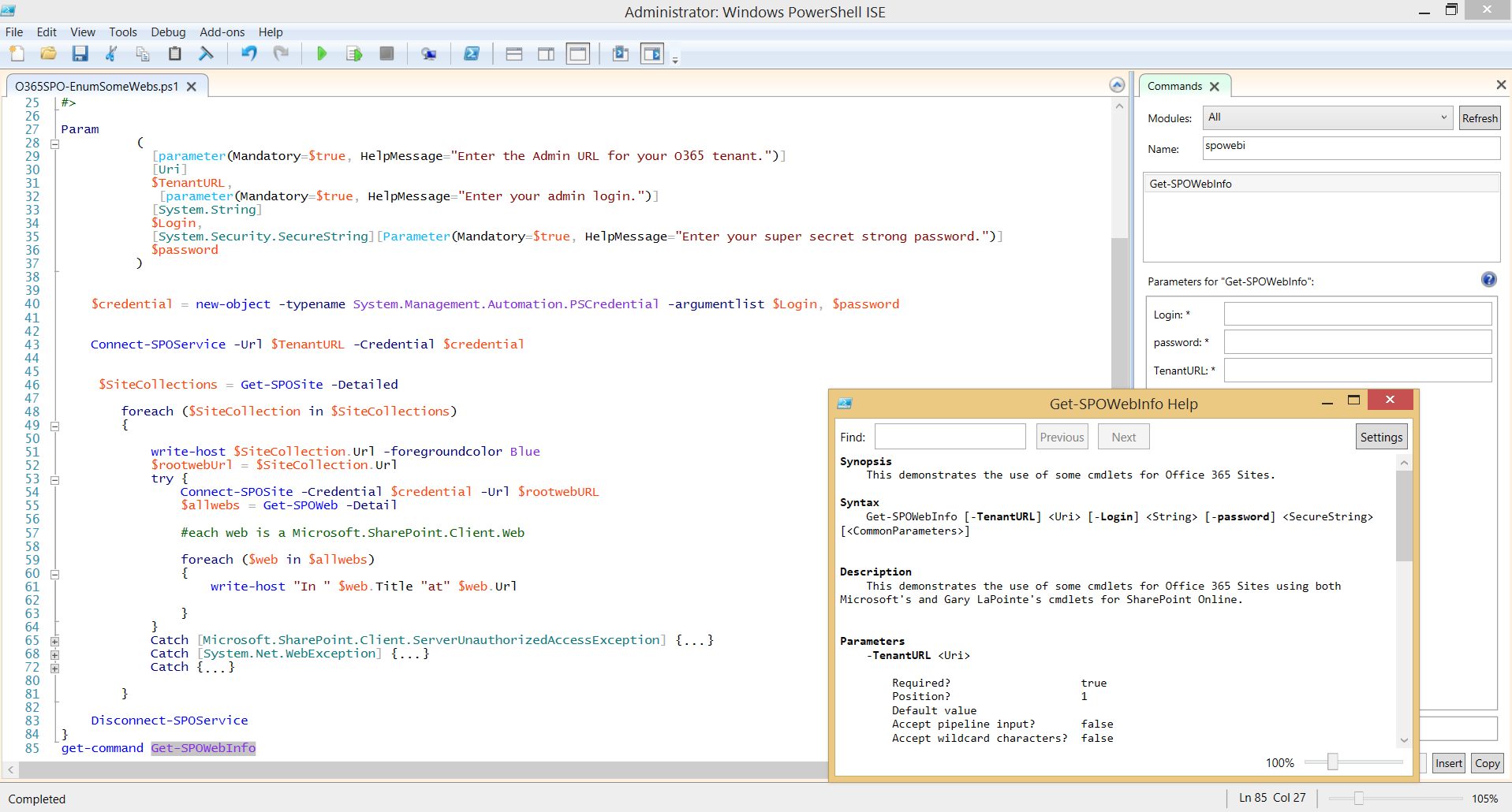Summary: Guest blogger, Michael Blumenthal shows how to findWindows PowerShell cmdlets that are available for Office 365 sites.
Microsoft Scripting Guy, Ed Wilson, is here. Today we have a new guest blogger, Michael Blumenthal, who we met in Chicago in May at Microsoft Ignite. Here is a little bit about Michael:
Michael Blumenthal is a technical solution evangelist with PSC Group and a Microsoft Office 365 MVP. As such, he is an experienced architect for SharePoint, and business technology advisor. Michael has deep SharePoint expertise, with two decades of development, infrastructure, and administration experience. He’s designed, implemented, and supported intranets, extranets, and Internet sites for clients in markets as diverse as banking, energy, government, and transportation.
Michael holds numerous Microsoft certifications (including most of the SharePoint certifications) and the Certified Associate in Project Management (CAPM) from the Project Management Institute. He can be found year round speaking on technology topics, including SharePoint and Windows PowerShell, at Chicago-area technology events and user groups.
Michael's contact info:
Blog: Michael Blumenthal, Office 365 MVP
Twitter: @michaelbl
You need Windows PowerShell 4.0
I assume you already have Windows PowerShell 4.0 installed. You will want two cmdlet libraries:
First, get the SharePoint Online Management Shell and install it. This will give you…wait for it…
37 SharePoint Online cmdlets.
I counted them this way:
get-command -Noun SPO* | where moduleName -like Microsoft.Online.SharePoint* | measure
Thirty-seven? Yes, only 37! But in SharePoint 2013 on premise, I had hundreds of SharePoint cmdlets available to me. What on earth will I do?
First, let’s look at what these 37 are:
PS C:\Windows\system32> get-command -Noun SPO* | where moduleName -like Microsoft.Online.SharePoint* |
Select-Object Name | Sort-Object Name
Name
—-
Add-SPOUser
Connect-SPOService
ConvertTo-SPOMigrationTargetedPackage
Disconnect-SPOService
Get-SPOAppErrors
Get-SPOAppInfo
Get-SPODeletedSite
Get-SPOExternalUser
Get-SPOSite
Get-SPOSiteGroup
Get-SPOTenant
Get-SPOTenantLogEntry
Get-SPOTenantLogLastAvailableTimeInUtc
Get-SPOTenantSyncClientRestriction
Get-SPOUser
Get-SPOWebTemplate
New-SPOMigrationPackage
New-SPOSite
New-SPOSiteGroup
Remove-SPODeletedSite
Remove-SPOExternalUser
Remove-SPOSite
Remove-SPOSiteGroup
Remove-SPOTenantSyncClientRestriction
Remove-SPOUser
Repair-SPOSite
Request-SPOPersonalSite
Request-SPOUpgradeEvaluationSite
Restore-SPODeletedSite
Set-SPOSite
Set-SPOSiteGroup
Set-SPOTenant
Set-SPOTenantSyncClientRestriction
Set-SPOUser
Submit-SPOMigration
Test-SPOSite
Upgrade-SPOSite
What about missing cmdlets?
What? No SPOWeb? Well, let’s get more cmdlets then! Gary LaPointe to the rescue! Go to APTILLON Sharepoint Automation and click Installer: Lapointe.SharePointOnline.PowerShell.msi.
Run that.
Now how many cmdlets do you have?
get-command -Noun SPO* | where moduleName -like Lapointe.SharePointOnline.* | measure
45! Yay! What are they?
PS C:\Windows\system32> get-command -Noun SPO* | where moduleName -like Lapointe.SharePointOnline.* |
Select-Object Name | Sort-Object Name
Name
—-
Add-SPOContentType
Add-SPOField
Add-SPOListViewWebPart
Add-SPOSolution
Add-SPOWebPart
Connect-SPOSite
Disable-SPOFeature
Disconnect-SPOSite
Enable-SPOFeature
Export-SPOSearchConfiguration
Export-SPOTaxonomy
Get-SPOContentType
Get-SPOContextSite
Get-SPOEventReceiver
Get-SPOFeature
Get-SPOFile
Get-SPOFolder
Get-SPOList
Get-SPOTerm
Get-SPOTermGroup
Get-SPOTermSet
Get-SPOTermStore
Get-SPOWeb
Get-SPOWebPart
Import-SPOSearchConfiguration
Import-SPOTaxonomy
Install-SPOSolution
Invoke-SPORestMethod
New-SPOContentType
New-SPOField
New-SPOFile
New-SPOList
New-SPOListFolder
New-SPOListItem
New-SPOTermGroup
New-SPOTermSet
New-SPOWeb
New-SPOWikiPage
Remove-SPOContentType
Remove-SPOList
Remove-SPOWeb
Set-SPOList
Set-SPOWeb
Set-SPOWebTheme
Set-SPOWikiPageLayout
Even more SharePoint cmdlets
Ah, that’s more like it! Cmdlets to work with lists and libraries. Now we’re talking!
However, if you want more cmdlets and some examples, take a look at this CodePlex project: Client-side SharePoint PowerShell.
Now that we have the cmdlets in the SharePoint Online Management Console and the cmdlets from Gary LaPointe, we can do things like this:
function global:Get-SPOWebInfo {
<#
.SYNOPSIS
This demonstrates the use of some cmdlets for Office 365 Sites.
.DESCRIPTION
This demonstrates the use of some cmdlets for Office 365 Sites using both Microsoft's and Gary LaPointe's cmdlets for SharePoint Online.
.PARAMETER TenantAdminURL
The Admin URL for your O365 Tenant. For example, if your tenant is https://foo.sharepoint.com, your Admin URL is https://foo-admin.sharepoint.com.
.PARAMETER Login
Your O365 login email.
.PARAMETER Password
Your O365 login password.
.EXAMPLE
get-SPOWebInfo -TenantAdminURL foo.sharepoint.com -Login login@somedomain.com -password SomeStrongPasswordGoesHere
.OUTPUTS
Writes out the URL of every web in every site.
.NOTES
Author: Michael Blumenthal, PSC Group LLC
#>
Param
(
[parameter(Mandatory=$true, HelpMessage="Enter the Admin URL for your O365 tenant.")]
[Uri]
$TenantURL,
[parameter(Mandatory=$true, HelpMessage="Enter your admin login.")]
[System.String]
$Login,
[System.Security.SecureString][Parameter(Mandatory=$true, HelpMessage="Enter your super secret strong password.")]
$password
)
$credential = new-object -typename System.Management.Automation.PSCredential -argumentlist $Login, $password
Connect-SPOService -Url $TenantURL -Credential $credential
$SiteCollections = Get-SPOSite -Detailed
foreach ($SiteCollection in $SiteCollections)
{
write-host $SiteCollection.Url -foregroundcolor Blue
$rootwebUrl = $SiteCollection.Url
try {
Connect-SPOSite -Credential $credential -Url $rootwebURL
$allwebs = Get-SPOWeb -Detail
#each web is a Microsoft.SharePoint.Client.Web
foreach ($web in $allwebs)
{
write-host "In " $web.Title "at" $web.Url
}
}
Catch [Microsoft.SharePoint.Client.ServerUnauthorizedAccessException] {
Write-Host -ForegroundColor Yellow "SUAE error."
}
Catch [System.Net.WebException] {
Write-Host -ForegroundColor Yellow "WebException."
Write-Host -ForegroundColor Yellow $_.exception.Message
}
Catch {
$ErrorMessage = $_.Exception.Message
$FailedItem = $_.Exception.ItemName
$ExceptionType = $_.Exception.GetType().FullName;
Write-host -ForegroundColor Yellow "Other exception: " $ExceptionType
Write-host -ForegroundColor Yellow Message: $ErrorMessage
Write-host -ForegroundColor Yellow Failed Item $FailedItem
}
}
Disconnect-SPOService
}
get-command Get-SPOWebInfo
Let's check it out
Now run Get-SPOWebInfo, and give it a try!
~Michael
Thank you, Michael. Great introduction to finding and using SharePoint cmdlet resources.
I invite you to follow me on Twitter and Facebook. If you have any questions, send email to me at scripter@microsoft.com, or post your questions on the Official Scripting Guys Forum. See you tomorrow. Until then, peace.
Ed Wilson, Microsoft Scripting Guy



Looking at this several years later, the 3rd party cmdlet libraries listed above are no longer needed. Use the PowerShell cmdlets from the Patterns and Practices repository on GitHub: https://github.com/SharePoint/PnP-PowerShell